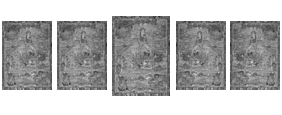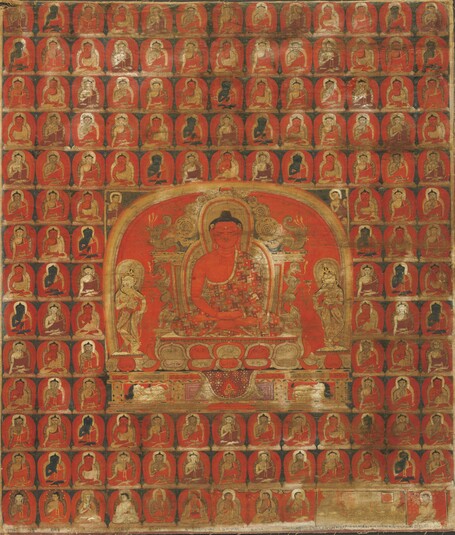
Item: Amitabha Buddha - Nirmanakaya
| Origin Location | Tibet |
|---|---|
| Date Range | 1300 - 1399 |
| Lineages | Taklung (Kagyu) and Buddhist |
| Material | Ground Mineral Pigment on Cotton |
| Collection | Private |
Classification: Deity
Appearance: Buddha
Gender: Male
Amitabha Buddha (Tibetan: o pa me. English: Immeasurable Light): surrounded by retinue figures and registers containing 127 Buddhas and Lineage Teachers (in the bottom register).
The central figure is most interesting because at first glance the identity appears to be that of Amitabha Buddha, red in colour, with the two hands placed one atop the other in the gesture of meditation, seated in cross-legged vajra posture with the right leg over the left. However, on a closer look then it becomes apparent that the typical black begging bowl in the lap is missing and on further inspection the throne is found to be supported by lions rather than the customary peacocks associated with Amitabha and the Padma Family of the Five Buddha system. It is possible that if this Amitabha composition belongs to a five painting set then maybe each of the Buddhas are seated on a lion supported throne. It is certainly not common but possible. As for the missing black begging bowl, although typical for Amitabha, is not always present as indicated by comparable paintings of Amitabha from West Tibet created at a comparable time period.
Accompanying the central figure, at the sides are two standing bodhisattva figures. On the left side the hand object held by the figure is not identified. On the right side the figure holds the stem of a flower blossom which in turn supports a book, usually the Prajnaparamita Sutra. It is possible that the figure on the right can be identified as Manjushri, although in some complex mandalas with numerous deities, other figures could also hold a book.
Above the Throne-back (torana) but within the square enclosure marking the space of the central Buddha and retinue, there are two monk figures at the right and left corners - just slightly above the arched rainbow halo. It might be possible that they represent the groups of arhats and pratyekabuddhas (with a single figure each) as can be found with Yoga Tantra depictions of the full sets of mandala deities in a five composition set of paintings.
Surrounding the central Buddha are thirteen horizontal registers containing one hundred and twenty-seven (127) Buddha figures. They are differentiated by alternating colours and alternating hand gestures. When calculating the number of buddhas, each with the same body colour, and comparing that to the other buddhas and colours - there is NOT an equal number of buddhas divided by colour, such as the five colours of the Five Buddha Families. And, just as important, the buddhas in the registers and having the same colour do not always depict the same hand gesture. There appear to be more than five colours employed for the 127 buddhas. Also, there are more hand gestures than the typical five found with the Five Buddha Families. In the bottom two registers containing buddhas there are four buddhas with a unique hand gesture different from all of the other buddhas. With these four the proper right hand is held out to the side of the body with the palm upraised similar to that of Green Tara performing the gesture of 'removing fear.' From this analysis it would appear that the artist is not intending or attempting to represent the Five Buddhas.
Typically when confronted with a Buddha figure at the center of a composition and rows of buddhas above, to the two sides, and below, aligned in registers, then it is likely to be a depiction of one of a small number of iconographic deity groupings. The most common grouping would be the Thirty-five Confession Buddhas. That of course is ruled out in this case because of the 127 buddha figures. The second iconographic group would be the One Thousand Buddhas of the Eon. This of course is a real possibility because it is also the last possibility that involves a known iconographic group, or program. Once the 127 buddha figures are divided between known painting sets with central Buddha figures then the problem of how many compositions are in the total set arises. Dividing 1000 by 127 would mathematically create a set of 7.8 paintings. Buddhists typically create sets of paintings having an odd number, not an even number. Not all of the 1000 buddhas would fit into a set of seven paintings given the composition at hand and comparing it to a similar painting of Vairochana Buddha which is certainly by the same artist and quite possibly from the same painting set. A set of eight paintings is highly unlikely. Increasing the possible set to nine would be taking to many liberties before exhausting all other possibilities and likelihoods.
It is interesting to note that the buddhas and their corresponding colours are arranged in organized patterns with angled lines of colour from the top down and inside to outside. However, this patterning is not uncommon and can be found with a number of other early paintings depicting the same subject of a central large Buddha and registers of smaller buddhas. (See other examples: 92011, 281, 69109, 69456 and 69102).
It is most probable that this Amitabha composition belongs to a set of five paintings depicting the Five Buddhas: Vairochana, Akshobhya, Amitabha, Ratnasambhava and Amoghasiddhi. This iconographic subject is both popular and common for West Tibet from the 11th to 15th centuries. It is also probable that the 127 buddhas in the surrounding registers will prove in time to either fit into an iconographic program that accords with one of the Charya or Yoga Tantra systems, or prove to be merit filled decoration functioning as adornment for the central subject of the composition. Paintings following this latter description are known as Repeated Figure Composition.

Along the bottom of the composition, beginning on the left side, are the figures of Nagaraja Buddha, Acharya Nagarjuna, Jowo Atisha, Dromton, Bodhisattva Shantarakshita, King Trisong Detsen, Lama Yarjon, Lama Namdag, and Khenchen Chog. Most of the inscriptions have spelling errors of one kind or another.
It is very likely that this figure inscribed as Lama Yarjon is the famous Sanggye Yarjon (1203-1272), the 3rd throne holder of the Taglung Kagyu Tradition. The following two teachers remain unidentified. If the identification of Lama Yarjon [TBRC P1818] is correct then it is safe to assume that the two unidentified teachers follow in the lineage of Sanggye Yarjon and therefore place the painting somewhere towards the end of the 13th century and beginning of the 14th century.
At the right side of the bottom register is an assortment of the eight traditional offerings arranged atop tripod stands in front of an unidentified donor figure situated at the extreme right side. It is not apparent whether the donor is wearing monastic robes or lay clothing.
Jeff Watt 7-2012
Numbered & Coloured Schematic: 1. Amitabha Buddha 2. Attendant Bodhisattva Figure 3. Attendant Bodhisattva Figure 4. Monastic Figure (shravaka?) 5. Monastic Figure (pratyekabuddha?)
Bottom Register (turquoise & violet): 6. Nageshvara Raja Buddha 7. Acharya Nagarjuna 8. Jowo Atisha 9. Dromton 10. Bodhisattva Shantarakshita 11. King Trisong Detsen 12. Sanggye Yarjon 13. Lama Namdag 14. Khenchen Chog 15. Donor Figure (violet colour)
Reverse of Painting
English Translation of Inscription: [Standard Buddhist prayers and dharani]
Special Features: (Printed script (Uchen), includes "Om Ah Hum" inscription)
Buddhist Deity: Amitabha Iconography
Buddhist Deity: Amitabha Buddha (Early Paintings)
Subject: Torana, Amitabha & Amitayus Buddha (Early Animal Depictions)
Buddhist Deity: Amitabha (Charya & Yoga Tantras)
Buddhist Deity: Amitabha Buddha, 阿弥陀佛, འོད་དཔག་མེད། (Painting Masterworks)
Painting Set: Five Buddhas (Guge Style)
Buddhist Deity: Amitabha Religious Context


